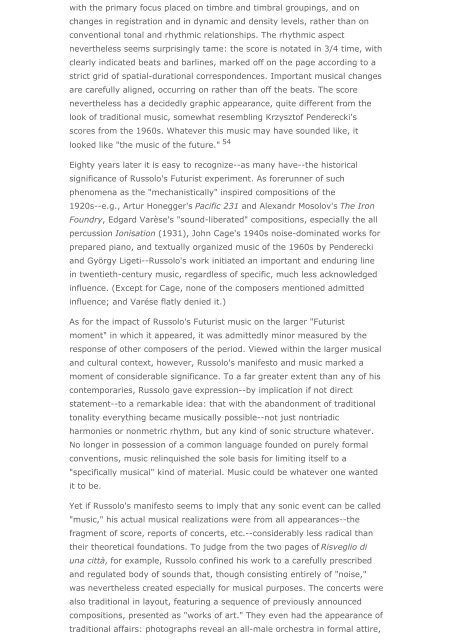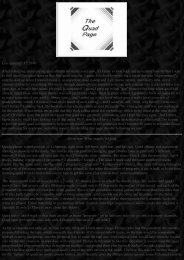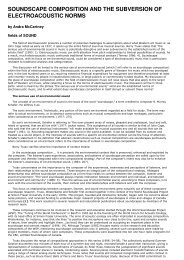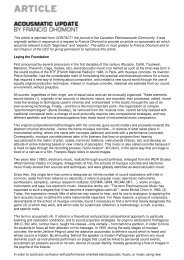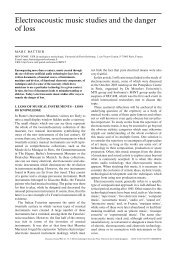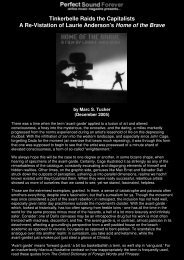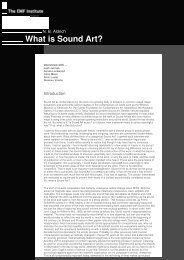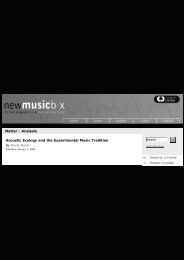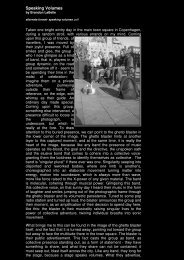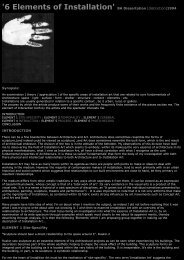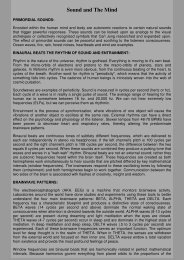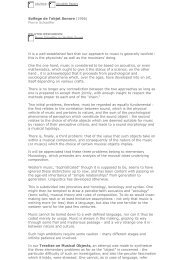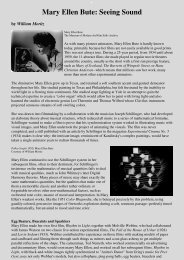Morgan-1994-A New Musical Reality- Futurism, Modernism and The ...
Morgan-1994-A New Musical Reality- Futurism, Modernism and The ...
Morgan-1994-A New Musical Reality- Futurism, Modernism and The ...
You also want an ePaper? Increase the reach of your titles
YUMPU automatically turns print PDFs into web optimized ePapers that Google loves.
with the primary focus placed on timbre <strong>and</strong> timbral groupings, <strong>and</strong> onchanges in registration <strong>and</strong> in dynamic <strong>and</strong> density levels, rather than onconventional tonal <strong>and</strong> rhythmic relationships. <strong>The</strong> rhythmic aspectnevertheless seems surprisingly tame: the score is notated in 3/4 time, withclearly indicated beats <strong>and</strong> barlines, marked off on the page according to astrict grid of spatial-durational correspondences. Important musical changesare carefully aligned, occurring on rather than off the beats. <strong>The</strong> scorenevertheless has a decidedly graphic appearance, quite different from thelook of traditional music, somewhat resembling Krzysztof Penderecki'sscores from the 1960s. Whatever this music may have sounded like, itlooked like "the music of the future." 54Eighty years later it is easy to recognize--as many have--the historicalsignificance of Russolo's Futurist experiment. As forerunner of suchphenomena as the "mechanistically" inspired compositions of the1920s--e.g., Artur Honegger's Pacific 231 <strong>and</strong> Alex<strong>and</strong>r Mosolov's <strong>The</strong> IronFoundry, Edgard Varèse's "sound-liberated" compositions, especially the allpercussion Ionisation (1931), John Cage's 1940s noise-dominated works forprepared piano, <strong>and</strong> textually organized music of the 1960s by Penderecki<strong>and</strong> György Ligeti--Russolo's work initiated an important <strong>and</strong> enduring linein twentieth-century music, regardless of specific, much less acknowledgedinfluence. (Except for Cage, none of the composers mentioned admittedinfluence; <strong>and</strong> Varése flatly denied it.)As for the impact of Russolo's Futurist music on the larger "Futuristmoment" in which it appeared, it was admittedly minor measured by theresponse of other composers of the period. Viewed within the larger musical<strong>and</strong> cultural context, however, Russolo's manifesto <strong>and</strong> music marked amoment of considerable significance. To a far greater extent than any of hiscontemporaries, Russolo gave expression--by implication if not directstatement--to a remarkable idea: that with the ab<strong>and</strong>onment of traditionaltonality everything became musically possible--not just nontriadicharmonies or nonmetric rhythm, but any kind of sonic structure whatever.No longer in possession of a common language founded on purely formalconventions, music relinquished the sole basis for limiting itself to a"specifically musical" kind of material. Music could be whatever one wantedit to be.Yet if Russolo's manifesto seems to imply that any sonic event can be called"music," his actual musical realizations were from all appearances--thefragment of score, reports of concerts, etc.--considerably less radical thantheir theoretical foundations. To judge from the two pages of Risveglio diuna città, for example, Russolo confined his work to a carefully prescribed<strong>and</strong> regulated body of sounds that, though consisting entirely of "noise,"was nevertheless created especially for musical purposes. <strong>The</strong> concerts werealso traditional in layout, featuring a sequence of previously announcedcompositions, presented as "works of art." <strong>The</strong>y even had the appearance oftraditional affairs: photographs reveal an all-male orchestra in formal attire,


